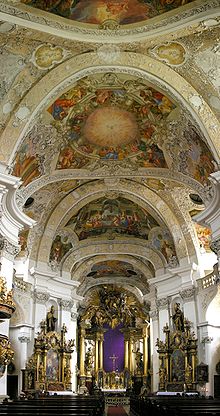Banz Abbey
This article includes a improve this article by introducing more precise citations. (July 2021) ) |
Kloster Banz | |
Benedictine | |
| Established | ca. 1070 |
|---|---|
| Disestablished | 1803 |
| Architecture | |
| Style | Baroque |
| Site | |
| Location | Bad Staffelstein, Germany |

Banz Abbey (
History

The abbey was founded in about 1070 by Countess Alberada of Schweinfurt and her husband, Count Hermann of Habsburg-Kastl, and until the secularisation of 1803 was the oldest monastery on the upper Main.
In the late Middle Ages and until 1575 only members of the nobility were accepted as monks.
After the
In the second half of the 18th century Banz Abbey was known throughout the Holy Roman Empire as a place of Catholic enlightenment and for the scholarship of its monks. This did not save it from secularisation and dissolution in 1803.
After dissolution
In 1813 Duke Wilhelm in Bavaria acquired the former abbey premises, which were thereafter known as Schloss Banz ("Banz Castle").
In 1933
The estate of the former monastery, including vast forests, is today owned by Duke
See also
Sources
- Dippold, G., 1991. Kloster Banz. Natur, Kultur, Architektur. Staffelstein: Obermain Buch- und Bildverlag.
- Wüst, W., 2001. Kloster Banz als ein benediktinisches Modell. Zur Stiftsstaatlichkeit in Franken. in: "Zeitschrift für bayerische Kirchengeschichte" 70 (2001), pp. 44–72.
- ISBN 978-3-943135-78-7.
External links
- (in German) Official website
- (in German) Klöster in Bayern: Kloster Banz
- (in German) History of the Upper Main: Banz
- (in German) Hanns-Seidel-Stiftung, Kloster Banz
